Research Question
How can animating the horizontal and vertical surfaces of a domestic environment, choreographed by the seasonal and diurnal ebb and flow of the Mequinenza water reservoir, shape users’ modes of habitation, accessibility, visibility, occupancy, and atmosphere?
Thesis Statement
Water fluctuation levels are a natural occurrence that can catalyze modes of habitation affected by the characteristics of the river. Levitating elevators, shifting panels, and other spatial motions are processes that affect the perception and utility of space. They can be energized by the power of tidal ebb and flow which equips the architecture with the necessary self-sufficiency to assist users in residing inside and around the river, a frequent destination for locals, visitors, fishermen, and kayakers.
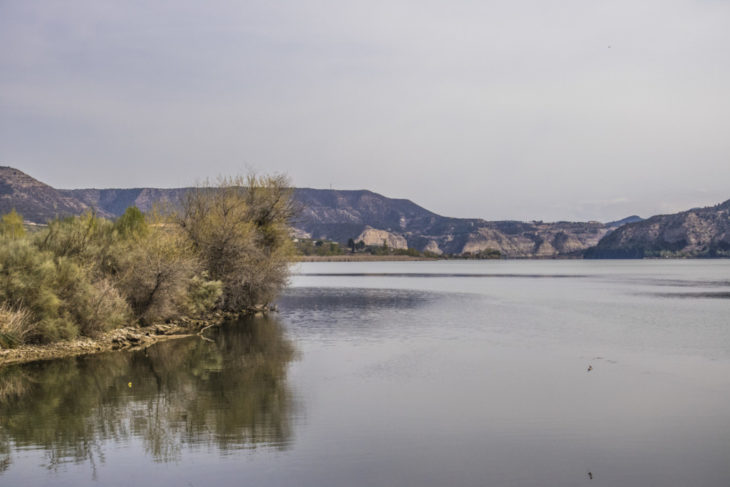
Site & Parameters
Tidal ebb & Flow is the reason that water exceeds and recedes on the shores. Ebb & Flow at the Mequinenza Reservoir is different both diurnally and seasonally. It’s affected by variables, such as river volume and time of year, that determine the water level fluctuation levels. The part of Mequinenza that we are dealing with is approximately 500 meters wide and is located at the far west of Catalunya, particularly at the edge that separates Catalunya from Aragon.

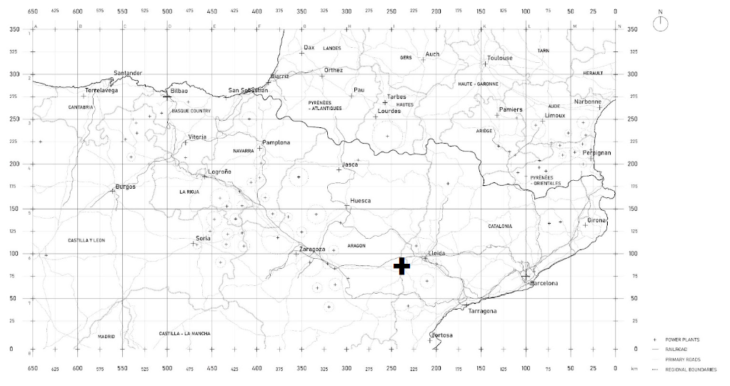
Water level fluctuation in the Spring and Summer happens at a higher level than that of the Fall and Winter. The difference is about 10-12 meters above sea level. The water on the first half of a Spring Summer day [00:00 a.m. to 11:59 a.m.] is lowering by ~1 meter, hence the convex nature of the graph. In the second half [12:00 p.m. to 11:59 p.m.], the water level regains the 1 meter drop.
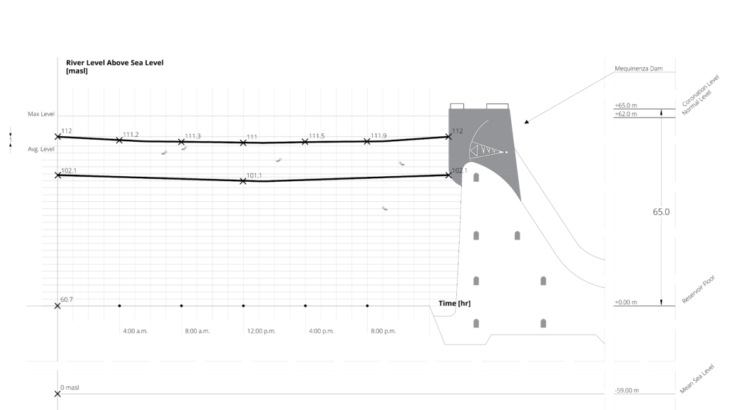
This has created four different levels of water and created four different ebb and flow lines of water at any point in a year. There is a maximum level of water and a minimum one for each of Spring-Summer and Fall-Winter. These lines in the water determined where, and how wide, an efficient SSB extends; in addition to how far it is to be placed from the coast to be situated in a place that experiences water level drops. Upon preliminary study, the belt marked by crosses, which is at a distance of 19 meters from the coast, experiences the most water level fluctuation in the Spring and Summer.
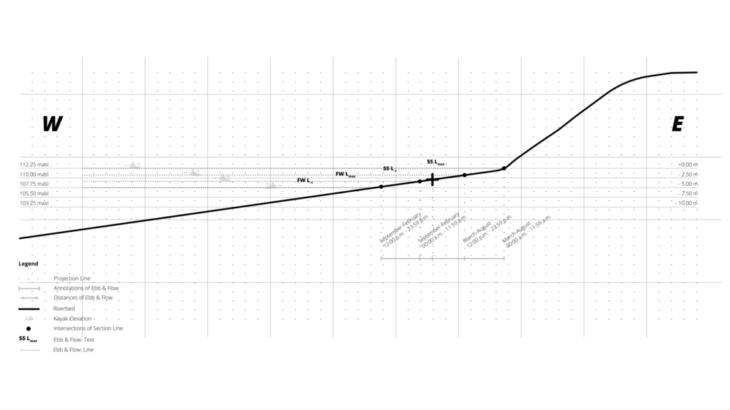

Peter Emerson’s photos from Life and Landscape in 1885 showed how farmers took advantage of the water level fluctuations in the river to gather more visible crops and travel to further grounds away from their residence. When the crops were more visible, they were visited to cut, when they were sunk in the water, the farmers avoided travelling and waited for the right hour of day.
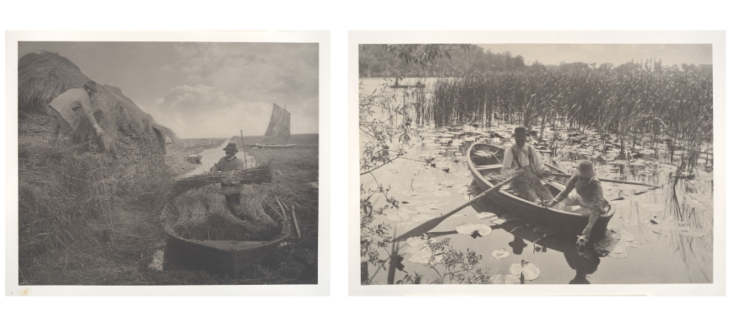
At 12:00 pm of mid-march, the river experiences a 1 meter diurnal drop in water level. This dynamic landscape becomes part of the architecture by enabling and disabling states of spatial continuity and discontinuity inside the cabin. Occupation capacity expands and diminishes in harmony too. That was taking place by the floatation of a horizontal elevator that in one instance is part of the clear ground, and in another instance becomes a step down due to the 1 meter level drop. In one part of the day, occupation capacity is higher and functions such as gathering and collective eating are doable; however, in another half, occupation capacity is lower and function is eclectic by accessing the lower part of the cabin which is the sunken deck. In the beginning of November, the 1 meter fluctuation happens at a lower level allowing the use of more lower ground levels. Visibility and light penetration is another variable that fluctuates rhythmically to the water levels by means of shifting vertical partitions. On the static ground, a panel is static, and the other slides in an intimate proximity to it as the horizontal elevator moves down. The ebb and flow orchestrate the light and vision, which shapes the users daily routine as a consequence. During the first half of the day [00:00 a.m. to 11:59 a.m.], the water level is lowering by ~1 meter: enabling light inlet, access to the sloped deck, and low occupation. In the second half [12:00 p.m. to 11:59 p.m.], deck access is forbidden, light is diminished, and occupancy is higher.
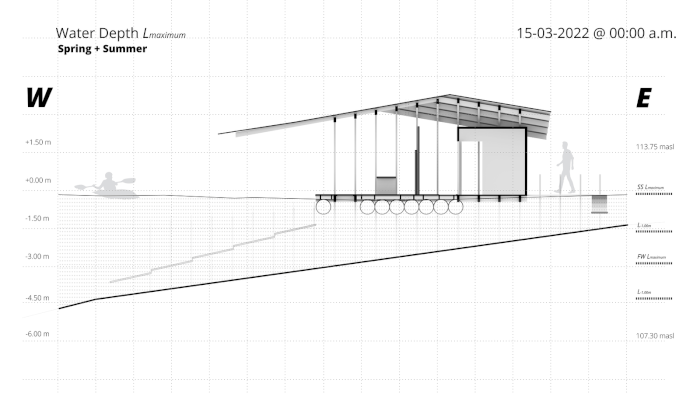
The separation of the elevator from the static ground resembles the buckle of a Los Angeles highway in 1994 when it buckled due to an earthquake. The architectural consequence of this separation is accessibility to a different level of the site. The floating market in Bangkok almost proves the opposite of the previous phenomena because it lobbies for floatation upwards as means to accessing a different level, or a different service in this case. The buying and selling is made possible by the higher levels of water. The water levels here shape the hours with which buyers visit the market.
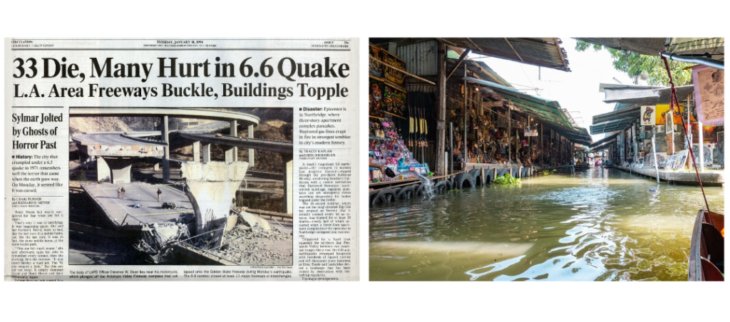
The movement of the partitions in opera house in Paris happens intimately. They are placed very close to each other that controls the amount of visibility and light receptivity of the viewer. It’s one way of orchestrating the viewer’s receptivity of information.
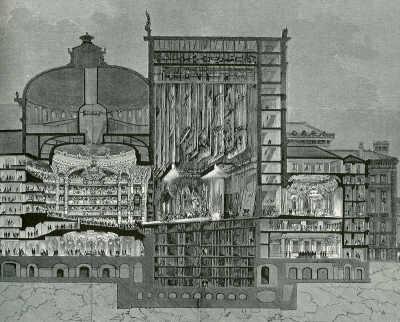
In our iteration, gradients of translucency and transparency were employed to generate the mechanism for our architecture. The patterns of the gradients collide as one partition slides by the other. This method has shown to work efficiently with circular patterns since they cover the most of residual space on the partitions. The glass façade of the cabin that is oriented towards the west receives the sunset which takes place at an hour when the water level is lower. When water is lower, the partitions slide downwards hence making the space luminous. Visibility to the outside also increases due to the transparency achieved by the gradients’ sliding partitions.
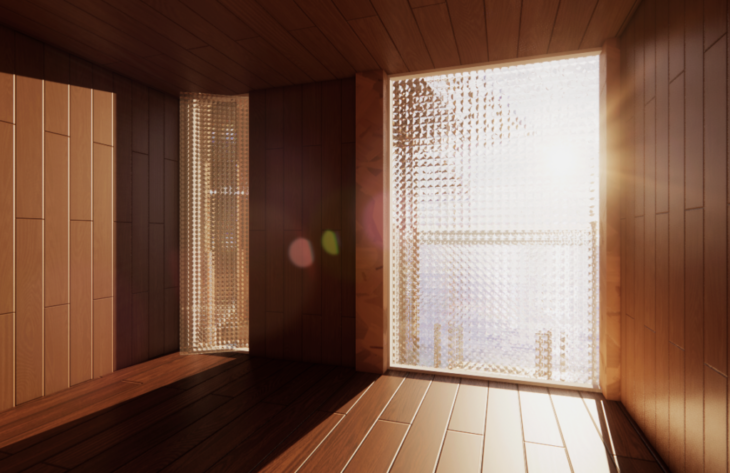
The performance of our device-experiment was a reference for the ever-changing loop of visibility. This performance took place because the more the water was contained, the less visibility occurred due to humidification. The lesser the water was collected, the lesser the humidification and hence more visibility.

Design Investigation
Geolocating and orienting the partitions was the most essential step towards the Self Sufficient Building. The partitions were placed on the right points along Mequinenza’s lines of Ebb & Flow that are affiliated to the time of day and hence the position of the sun. The geo locations were derived from the points that experience water fluctuation differently based on time of the day and season of the year. Furthermore, they were oriented towards the sun relevant to their geolocations. The horizontal elevators and vertical partitions move downwards since they are attached to the moving parts of the Self Sufficient Building. The dynamic elevators affect the user’s daily routine when they react to the dynamic landscape. These dynamic elevators connect the interior spaces, conveyed by dark shapes, to the lower levels at different hours of the day. The interiorities have access to the surrounding hybrid space which connects all the vertical partitions and horizontal elevators together. The movement of the two affect the modes of habitation. Namely, entrances and exits to the self sufficient building are orchestrated. Eastern entrance is solely enabled in the first part of the day during the Spring and Summer; whereas, entrances from all directions are enabled on the second half of a Fall Winter day.
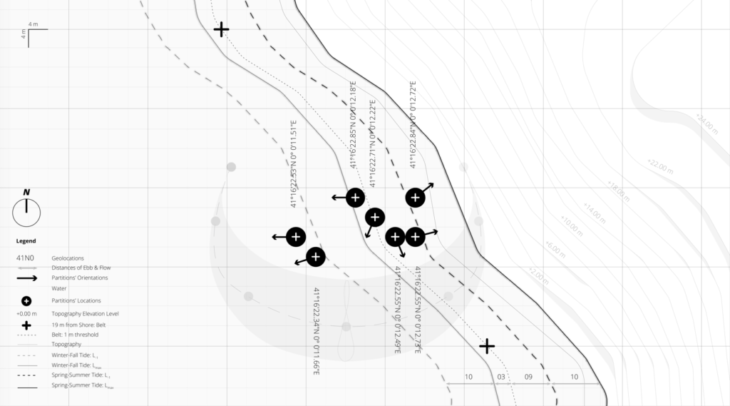
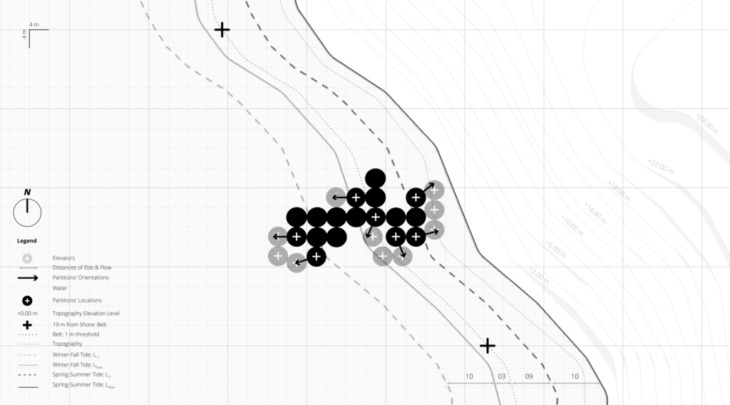
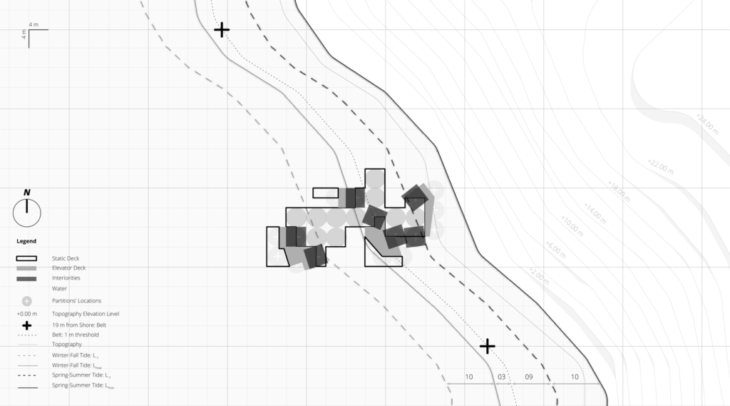
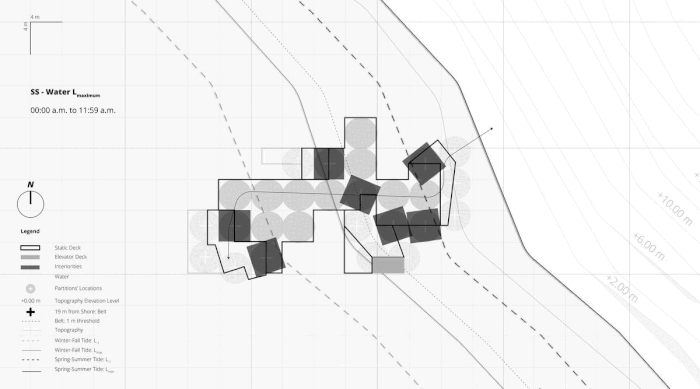
In fact, the water level fluctuation on a typical Spring Summer day can be dissected into three parts: chronologically, they are water descending, stagnation, and ascending. When water is descending, sleeping/ cooking/ and resting happen while visibility and light inlet decrease. When water levels are in stagnation, access to the deck, swimming, bathing, high visibility and low occupation take place. Horizontal light strikes the entire building when water is ascending very slowly and disappears upon water ascending.

The habitation amounted to a minimum of 5 habitations. A family of 4 and 1-2 guests were intended to be hosted. The distribution of function for these 6 individuals was decentralized allowing each box to celebrate autonomy in some moments: however, decking/ swimming/ collective eating/ and gathering which are the functions affiliated to the visitors and site, happen in the hours with which the site permits.
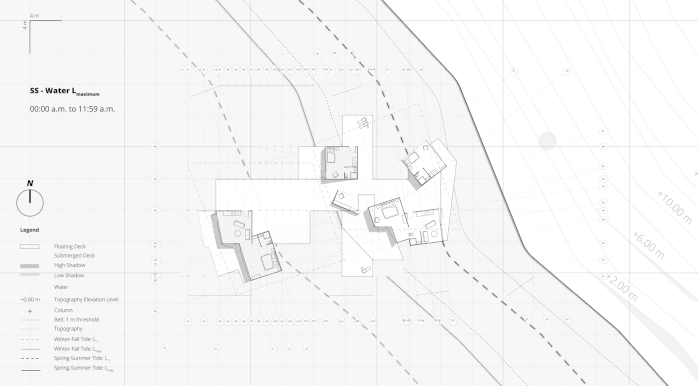
The status of the self sufficient building during the second half of a fall-winter day is only partially emerged in water. It’s an extreme moment which experiences some horizontal light due to shifted partitions, holistic access and exit to and from the architecture, and the appearance of the lowest sunken deck. The level of the water determines how much of the structure is visible.
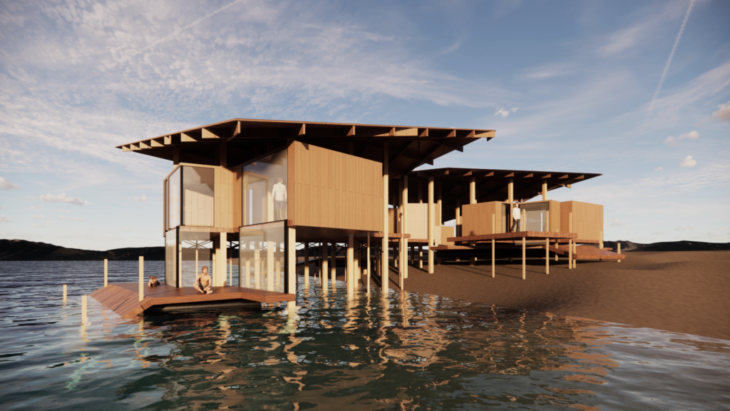
The visibility of the poles on a platform half sunken in water in Lisbon, Portugal, shows that the level of water is not only determined from the pole’s height that is exposed, but also by the aquatic plant’s visibility, acting as a indicator of water depth status.

The part of the columns that do not sink in the water create shadows especially along the longitudinal access of the building. The static deck that connects the interiorities is roofed and experiences shadows in all directions. When placed under the afternoon sun. The 1:5 construction exhibits the anticipated shadows along the hybrid space. The columns were distributed in a way that carry the intended waffle structure for the roof. The roof that covers the deck is closer to the elevators that move downwards and further from the static parts of the deck which resulted in a pitched roof. The structure evokes shadows that become part of the atmospheric change which fluctuates with the water levels.
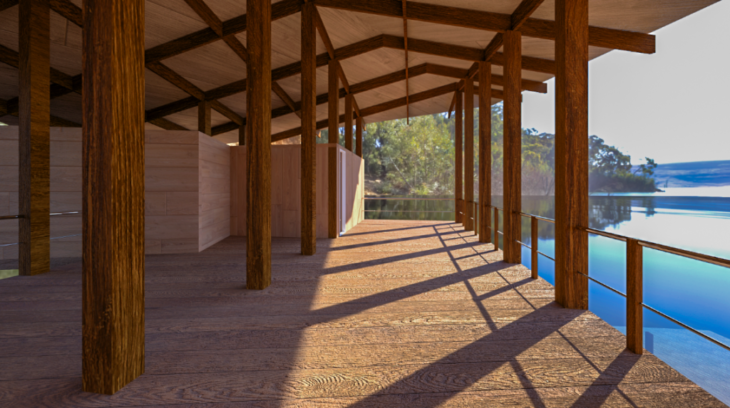
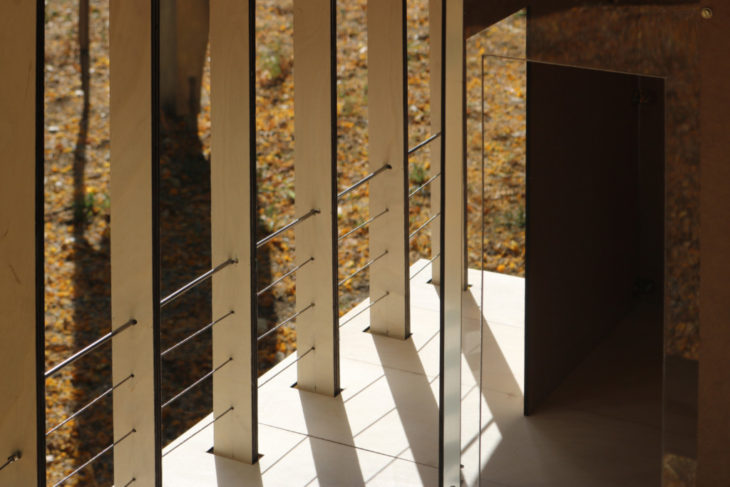
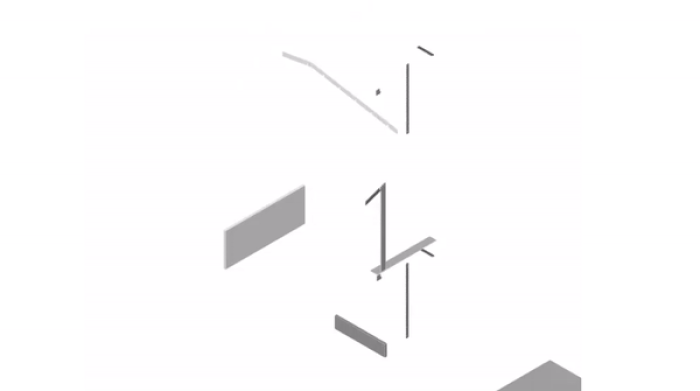
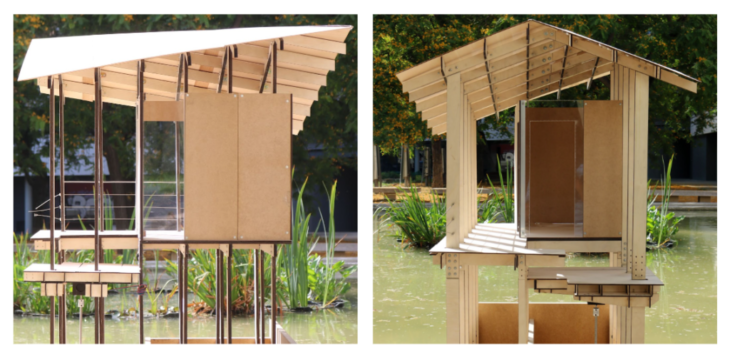
The building sections convey the site characterized by water levels during the months of January and December as opposed to March and November which were the previously studied months. The range of fluctuation becomes 85 to 95 cm rather than 1 meter, which creates tiny steps between the elevators and lower decks. As opposed to a complete flush of the two horizontal surfaces that takes place between March and November. Having said so, the building continues to experience a noticeable adaptation to the dynamic landscape. One that is cumulative.
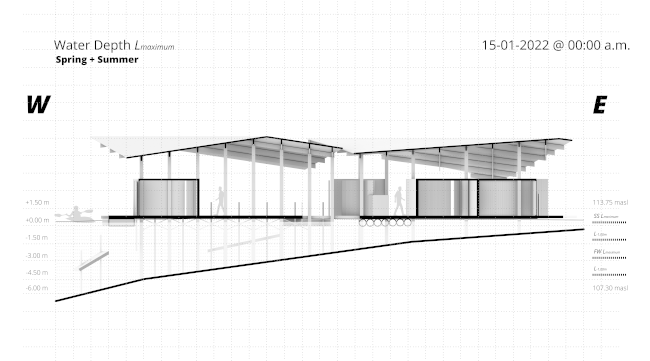
In this architecture, water level and visibility are indirectly proportional. When one increases, the other decreases, and vice versa. Water level is also indirectly proportional to access and exit. However, water level and atmosphere are directly proportional. When water levels are fluctuating, horizontal and vertical surfaces are shifting rhythmically. The Mequinenza Reservoir experiences this animation diurnally and seasonally due to the Ebb & Flow; which, in turn, affects the use of the domestic environment.
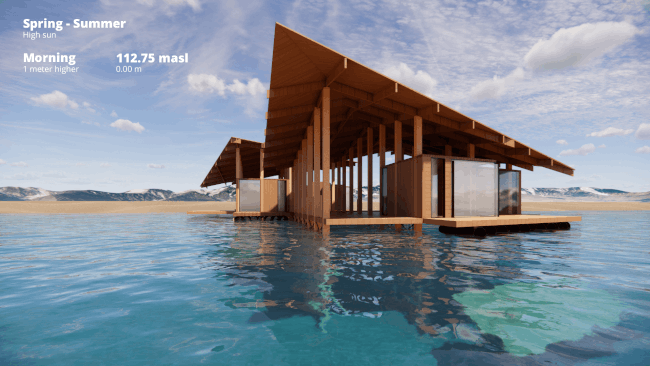
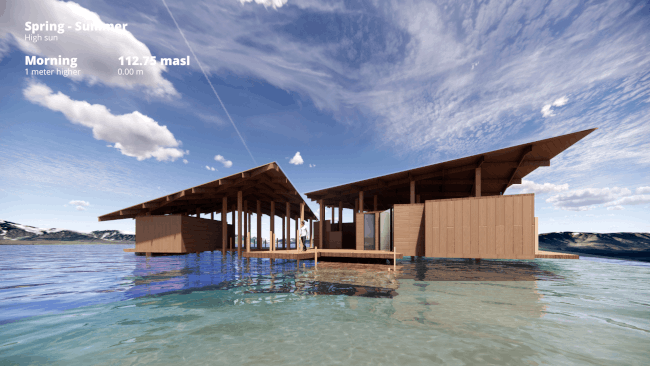
Ebb & Flow for Self Sufficiency is a project of IAAC, Institute for Advanced Architecture of Catalonia developed at Masters in Advanced Architecture (MAA 01), 2021/ 2022 by students: Nader Akoum and Aswin Kumar Ganesan; faculty: Eduoard Cabay, Raimund Krenmueller; student assistant: Elena Petruzzi.